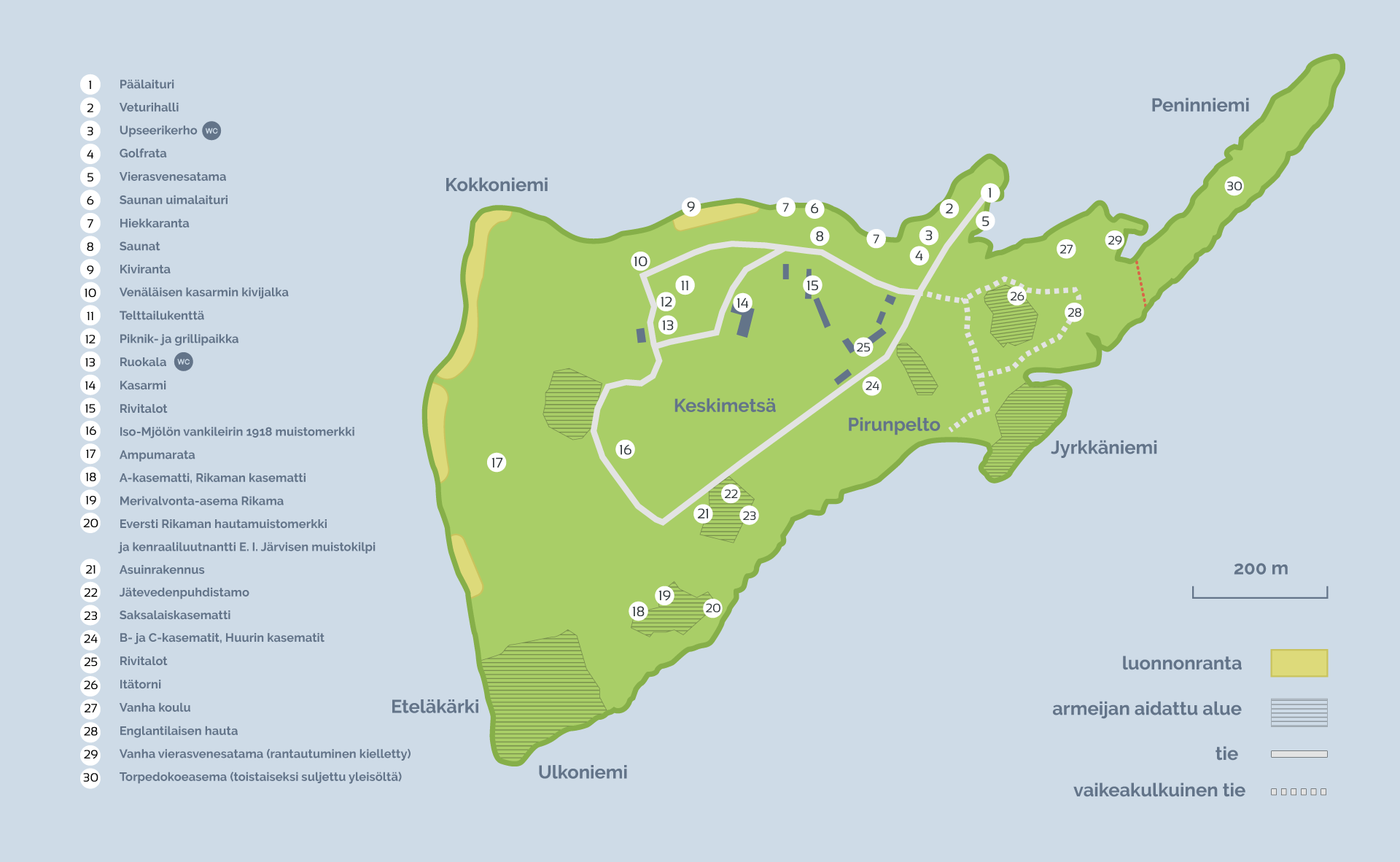
1. Main pier
2. Engine shed. A railway locomotive designed to transport cannons was kept here. Railroad tracks still exist inside the shed but have been taken up in the rest of the island. The locomotive itself was scrapped in 2014. Nowadays the building houses oil spill prevention equipment.
3. Officers’ mess (‘Upseerikerho’). The building was erected in the late-19th century during the Russian era. Originally, it served as a bakery but was later used for living quarters. During Finland’s involvement in the Second World War, recruits of Lotta Svärd, the Finnish voluntary paramilitary foundation, lived there. Since the 1960s, Isosaari officers’ mess has been at the heart of the island’s social life, offering shows and other entertainment to its residents. The building got a facelift in 2017.
4. Golf course. In the late 1980s, residents of Isosaari island clubbed together and built the golf course one hole at a time. The nine-hole course, completed early in the new millennium, is reckoned to be the most difficult par-3 course in Finland.
5. Marina for visiting boats and yachts
6. Swimming dock by the sauna
7. Sandy beach
8. Saunas. There are three public saunas on the island. The biggest sauna can be found in a building constructed in 1942 that has national romantic and Karelian architectural features.
9. Stone beach
10. Location of the Russian barracks. Isosaari’s first barracks were located here. They were simple and ascetic and were later upgraded.
11. Camping area. Camping on the island is permitted on the old parade ground.
12. Picnic and barbeque spot. Cooking is permitted near the camp area. Running water, dishwashing facilities and toilets are nearby.
13. The canteen. The canteen was built in the 1930s and has also been used as a cinema (the entrance to the projector room is located above the main entrance). Over the years, the canteen has undergone much renovation and all the equipment is now up to date. Nowadays the canteen is used for group meetings and bookings.
14. Barracks. The architecture of the barracks resembles that of barracks in other fortresses. The building was in use until 2012 but is now facing demolition and closed to the public.
15. Terraced houses. In the 1960s six terraced house complexes were built in the island to meet the needs of approximately thirty families. The houses were inhabited by cadre members and their families. The rents were low and the amenities similar to those on the mainland. Today these houses are faced with demolition.
16. 1918 Iso-Mjölö prison camp memorial. Around 1,500 Red prisoners were held at the island. Many died of diseases or were executed. A memorial for the prisoners was later erected.
17. Firing range
18. Casemate A, Rikama casemate
19. Marine surveillance base Rikama
20. Cenotaph of Colonel Rikama and memorial plaque of Lieutenant General E.I. Järvinen
21. Dwelling. The only permanent inhabitant of the island and also the southernmost inhabitant of Helsinki lives in the house.
22. Sewage treatment plant. The island has its own sewage plant. Tap water comes from the mainland through a pipe.
23. German casemate
24. Casemates B and C. Attention! It is prohibited to walk along the top edge of the casemates. There are metallic masking net fasteners by the fence that present a tripping hazard. The slopes and footpaths are slippery in wet weather. Children must be supervised. Construction of the three large casemates began in 1913 and was completed in 1915. Casemates B and C were later unofficially referred to as Huuri casemates after Aleksanteri Huuri, a colonel in the pioneer corps who worked in Isosaari in the 1930s.The Isosaari casemates have unique slope-like entrances unlike the fortifications in Viapori (Suomenlinna). The casemate walls still have niches for icons as a relic of the period under Russian rule. Casemate B was originally armed with four 11” Durlacher guns and casemate C with four 6” Canet guns. Canet guns had been manufactured at the Obukhov State Plant in St. Petersburg since 1891. At the turn of the 1920s and the 1930s they were modified and modernised in Isosaari under Colonel Rikama’s supervision. From the 1950s the Canet guns of the coastal artillery were upgraded with new 152mm gun barrels manufactured by Tampella. The guns were also installed with armour-plated gun shields. A final major upgrade took place in the 1980s when the Canets were replaced with 130 53 TK turret guns.
25. Terraced houses (see section 15). Next to the terraced houses there is also a new school building that nowadays serves as a maintenance building.
26. East Tower
27. Old School
28. The Englishman’s Grave. At the end of the Crimean war in 1855 the British navy attacked the Viapori fortress. The dated Russian-made guns of the fortress were not enough to effectively defend against the fire of 81 enemy ships. The battle claimed the lives of 63 Russian and Finnish defenders and a memorial is to be found on the neighbouring island of Santahamina.
The war also claimed the life of English leading seaman George Quinnell, aged 35, who was serving on the steam frigate HMS Amphion. He died during a scouting mission prior to the battles. It is understood he lost his head to a cannonball fired from Santahamina. His body was later identified from his epaulettes and is buried on Isosaari. In 2003 the British Ambassador to Finland visited the grave and laid a wreath on it.
29. Old Visitor’s Marina (mooring prohibited). The marina is being demolished.
30. Torpedo Testing Site. This building houses the facility built in the years 1933–36 from which live firing exercises were carried out. The muzzle doors point out to the open sea and the torpedo testing tanks still exist. The building is currently closed for safety reasons.
Customer Service (weekdays 9.00-15.00)
0102023780
(1,51 €/call + lan)
Charter Cruises (weekdays 9.00-17.00)
0102023781